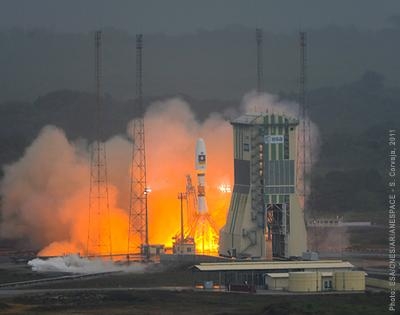Sat, Oct 22, 2011
Arianespace Places Two Satellites In Orbit Aboard Russian-Built
Launch Vehicle
The first Soyuz launch vehicle to lift off from Arianespace's
facility in French Guiana successfully placed Europe’s first
two Galileo navigation satellites into orbit Friday. Lifting off
from the ELS launch site in the Spaceport’s northwestern
sector, Soyuz performed a 3-hour 49-minute flight to inject its two
Galileo In-Orbit Validation (IOV) spacecraft into a 23,222-km.
circular medium-Earth orbit, inclined 54.7 degrees.

With Friday's nominal launch, Soyuz
enters Arianespace’s growing launcher family –
providing a medium-lift vehicle operating at the Spaceport
alongside the heavy-lift Ariane 5, and to be joined in 2012 by the
lightweight Vega at French Guiana.
Soyuz has served as the launch vehicle for manned and unmanned
missions from its long-operating launch bases at Baikonur
Cosmodrome in Kazakhstan, and Russia’s Plesetsk Cosmodrome.
The maiden flight from its new “home” at the Spaceport
marked Soyuz’ 1,777th launch, and began at 0730:26 local time
in French Guiana – enabling the Galileo satellites’
injection into their proper orbital plane.
Arianespace Chairman & CEO Jean-Yves Le Gall noted that Soyuz
already has become a commercial success, with 14 firm payload
contracts booked for missions with this medium-lift vehicle from
the Spaceport – all signed prior to today’s inaugural
flight. He recognized the determined efforts of those who advanced
the Soyuz at French Guiana project from its first studies in the
late 1990s to a successful introduction today – stating that
the project’s key players are true space visionaries.
“Bravo Europe…bravo Russia…bravo
cooperation,” Le Gall added during comments made at the
Spaceport’s Jupiter mission control center.

Compared to other Soyuz launchers, the version used by
Arianespace at the Spaceport incorporates a new digital control
system that increases flight authority during the launcher’s
atmospheric ascent, and enables the use of an enlarged ST-type
payload fairing for greater flexibility in accommodating spacecraft
passengers.
It also is equipped with the Fregat upper stage, which is designed
as an autonomous orbital vehicle and has the capability to be
restarted up to 20 times in flight – enabling complex payload
deployment profiles to be performed. (Images courtesy
Arianespace)
More News
Option Approach An approach requested and conducted by a pilot which will result in either a touch-and-go, missed approach, low approach, stop-and-go, or full stop landing. Pilots >[...]
"Emirates is already the world's largest Boeing 777 operator, and we are expanding our commitment to the program today with additional orders for 65 Boeing 777-9s. This is a long-t>[...]
(Pilot) Reported That There Was A Sudden And Violent Vibration Throughout The Airplane That Lasted Several Seconds Analysis: The pilot was returning to his home airport at an altit>[...]
“This recognition was evident during the TBMOPA Annual Convention, where owners and operators clearly expressed their satisfaction with our focus on customer service, and enc>[...]
Overhead Maneuver A series of predetermined maneuvers prescribed for aircraft (often in formation) for entry into the visual flight rules (VFR) traffic pattern and to proceed to a >[...]
 ANN's Daily Aero-Term (11.19.25): Option Approach
ANN's Daily Aero-Term (11.19.25): Option Approach Aero-News: Quote of the Day (11.19.25)
Aero-News: Quote of the Day (11.19.25) NTSB Final Report: Sting Sport TL-2000
NTSB Final Report: Sting Sport TL-2000 Aero-News: Quote of the Day (11.20.25)
Aero-News: Quote of the Day (11.20.25) ANN's Daily Aero-Term (11.20.25): Overhead Maneuver
ANN's Daily Aero-Term (11.20.25): Overhead Maneuver




